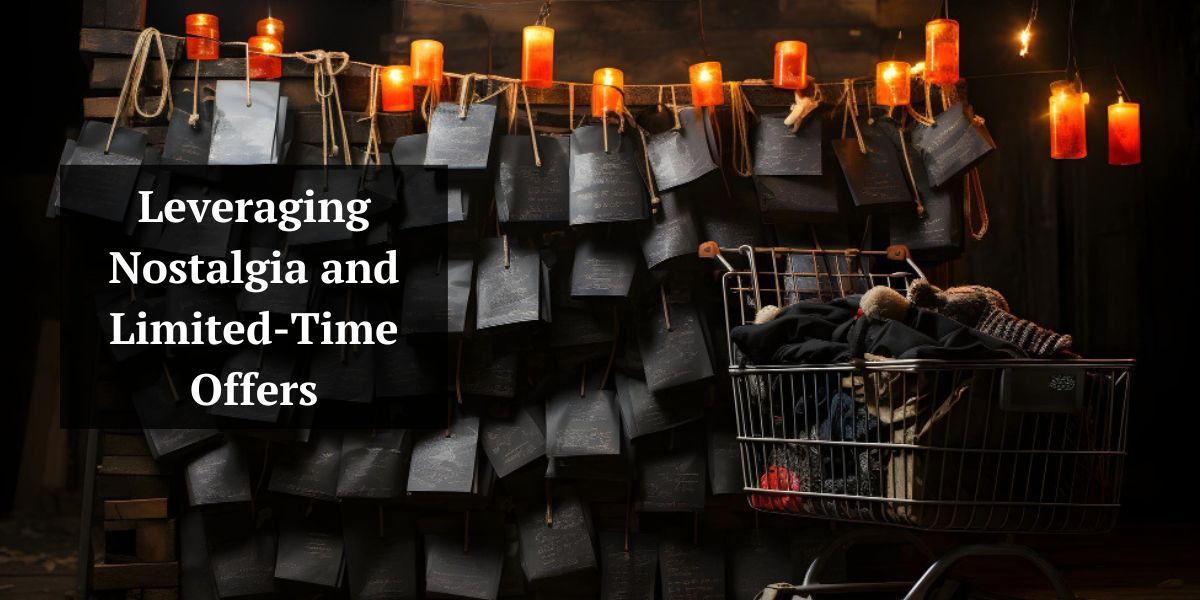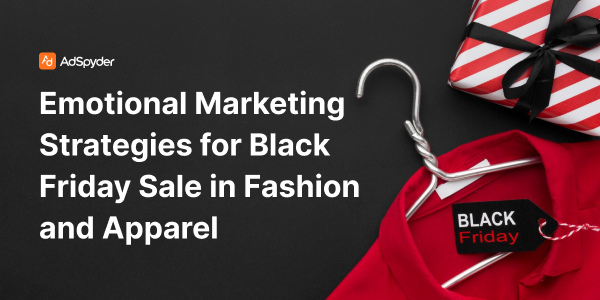Every year, Black Friday comes with massive discounts that are today in turn synonymous with consumer frenzy. At such times, fashion and apparel brands can look forward to getting higher sales in a way that, though being dependent on the scale of its reductions, is heavily reliant on the emotional message it brings to the customer and serves as an interesting narrative to let buyers convert. This blog shares ideal methods for fashion brands to capitalize on Black Friday Fashion Ads frenzy through employing emotional marketing strategies.
Ready to Elevate your Marketing Strategy?
Understanding Emotional Marketing

Emotional marketing differs from logical marketing as it uses an appeal to emotion so that a consumer behaves in a specific way when purchasing the given product. The psychology of consumer behavior can help fashion brands find specific emotions that can be tapped into to create an effective marketing campaign for fashion products.
Some of the major emotions that are employed in marketing are as follows:
- Nostalgia: A memory and association with past experiences which has pleasant feelings
- Exclusivity:Creating a feeling of scarcity or access only through a limited number.
- Fear of missing out (FOMO): Engendering scarcity and anxiety that you will miss the offer.
- Social proof: Leveraging peer pressure and validation to initiate purchase behavior.
Emotional marketing enables the brands to create a deeper connection with the consumers, making loyalty and repeat business happen. Given the knowledge about what emotions drive consumer behavior, fashion brands can craft marketing messages from an angle that would properly target their target audience.
Leveraging Nostalgia and Limited-Time Offers

Harnessing the nostalgia in marketing can be transmitted emotionally, taking the customers back to a familiar place, warm feelings and events. Combined with time-sensitive offers, such a strategy stimulates prompt decisions and actions on their part, since these customers now feel two principal motivating factors: the temptation of precious memories coupled with the promptness to grab exclusive offers while they still are available.
Nostalgia: A Powerful Marketing Tool
Nostalgia can be quite the powerful force as it provokes good memories and emotions associated with good times. Channeling customers’ fond memories provides a fashion brand with a powerful connection to the customer’s soul, where their very senses of pride and self-importance are self-asserted by purchasing a particular product. Here is how you can make use of nostalgia for your Black Friday Fashion Ads:
- Reintroduce classic styles: This includes bringing back or revival of mythical designs or collections that were worn earlier.
- Use vintage-inspired aesthetics: Use nostalgic motifs, such as old times font, color, and pictures in your marketing material.
- Highlight heritage and craftsmanship: Highlight history and tradition in your brand and products.
- Collaborate with nostalgic brands or celebrities: Partner with brands or celebrities that bring out some form of nostalgia in people for coming up with limited-edition collections or campaigns.
Creating a Sense of Urgency

Limited-time offers give customers the feeling of urgency compelling them to act quickly. Therefore, when the Black Friday Fashion ads are portrayed as being time-sensitive, fashion brands may create apprehension that people will miss the best offers available if purchases are not done promptly. The following are some effective ways to create a sense of urgency:
- Use countdown timers: Put countdown timers on your website and social media so that you create a sense of urgency.
- Offer limited quantities: Highlighting limited quantities of certain products will create a scarcity effect.
- Use phrases like “Last Chance” or “Don’t Miss Out”: This phrase often triggers people’s tendency for urgency and compels them to make that move during a certain period of time.
- Offer exclusive early access: Some Black Friday deal access should be given to VIP customers, or for email newsletter subscribers.
Nostalgia and time-limited offers can be very cleverly utilized by fashion brands to create a narrative that will then appeal to their target consumers and create interest on Black Friday.
Dive in: Black Friday Beauty Ads
Exclusivity and VIP Experiences
Creating a sense of exclusivity through VIP experiences enhances customer loyalty and engagement by making individuals feel valued and special. By offering unique access to events, products, or services reserved for a select group, brands can cultivate a stronger emotional connection and encourage word-of-mouth referrals, driving both brand affinity and sales.
The Appeal of Exclusivity
The feeling of being an exclusive entity can make customers feel privileged and valued. For example, a fashion brand can create an in-group feeling by allowing VIP members or those who sign up for newsletters to shop Black Friday Fashion Ads before anyone else or limited-edition products that will be sold only for a little while longer.
For example, Nike has an exclusive access-to-release option in its sneaker drop for the members of its Nike SNKRS application. Exclusives build anticipation and add a level of exclusivity.
Personalized Shopping Experiences
Personalized shopping experiences can also create exclusivity. Tailor-made recommendations or virtual styling consultation could just be enough to demonstrate that a company has an interest in its customers’ satisfaction and produce a more personalized shopping experience.
Here are some techniques with which personalized shopping experiences may be rendered.
- Use customer data to personalize recommendations. Use purchase history, browsing behavior, and preferences to suggest products based on the information available in relation to customer purchase history, browsing behavior, and preferences.
- Offer virtual styling consulting: This may link the client with a stylist who could offer on-site personal recommendations for styling.
- Create personalized lookbooks: Develop a lookbook for the customer based on his preference or style.
- Offer Exclusive services: For instance, alterations or bespoke fittings for VIP clients.
Of course, exclusive experiences and personalized service will always form a base of an in-depth relationship with the customers and loyalty.
Creating Interactive Experiences for Black Friday Fashion Ads
This table outlines strategies for using interactive experiences to enhance Black Friday fashion ads, improving engagement and sales.
| Interactive Experience | Implementation Strategy | Benefit |
| Virtual Try-Ons | Use augmented reality (AR) to let customers virtually try on clothing or accessories. | Increases user engagement and boosts confidence in buying decisions. |
| Interactive Polls and Quizzes | Create polls or quizzes to help customers find the right style or product. | Enhances personalization and captures user preferences for targeted offers. |
| Gamified Shopping Experiences | Incorporate games where users can unlock discounts or rewards for completing tasks. | Encourages longer interaction times and increases brand loyalty. |
| Live Streaming with Shoppable Links | Host live sales events where customers can purchase featured items directly through embedded links. | Drives real-time sales and creates a sense of urgency. |
| 3D Product Views | Offer 360-degree views of products, allowing customers to explore details interactively. | Provides a more comprehensive view, leading to higher conversion rates. |
Social Proof and Influencer Marketing

Utilizing social proof through influencer marketing leverages the credibility and trust that influencers have built with their audiences. By showcasing endorsements, reviews, and testimonials from trusted figures, brands can enhance their reputation and encourage potential customers to take action, as the validation from influencers reassures them of the product’s quality and desirability.
The Power of Social Proof
Social proof is that psychological phenomenon whereby people use the thoughts of others in making a decision. Thus, it turns out to be a very potent tool for marketing fashion if customers’ opinions in reviews, testimonials, and user-generated content are to be seen in public.
Leveraging User-Generated Content
User-generated content is the gold mine of social proof. When you get customers to share experiences with your product over social media, you are actually creating a real-life example of how the products you sell are utilized and appreciated by everyday people. This is how you use user-generated content for brand-building:
- Create a branded hashtag: Ask that customers use a branded hashtag anytime they share images or videos of your products.
- Run contests or giveaways: Encourage customers with incentives such as a chance of winning a prize to share their experience and tag your brand.
- Feature UGC on your website and social media: Use customer-generated content for marketing materials to serve as a proof of using your product by others.
Collaborating with Influencers
Through influencing marketing, social proof can be enhanced. Influencers who resonate with the target market are those who, through partnering with them, help bring your brand closer to a wider audience. When these individuals give authentic recommendations and endorsements, their influence can be maximized in propelling the sales.
When selecting influencers, consider the following factors:
- Relevance: Select an influencer whose audience falls with your target market.
- Engagement: Select influencers who demonstrate a high engagement and interaction with their followers.
- Authenticity: Employ influencers that have an authentic reputation and provide genuine recommendations.
Creating Authentic Influencer Partnerships
Steer clear of content that is too promotional or script-like. Demonstrate authentic interests in actually establishing true relationships with influencers, and thus allowing them to express their honest opinion of your products.
Some keys towards creating authenticity within influencer partnerships include the following
- Provide influencers with products to try: Give influencers enough time to test and experience your products.
- Encourage natural content: Don’t give the influencer overly scripted or promotional content. Let them narrate their true experience in their own words.
- Offer flexible collaborations: Be amenable to different kinds of collaborations, which can be sponsored posts on Instagram, Instagram Stories, or product reviews.
By effectively leveraging social proof and influencer marketing, fashion brands can build trust, credibility, and ultimately drive sales.
Check this out: Black Friday Marketing for Travel
Storytelling and Brand Identity For Black Friday Fashion Ads
Storytelling plays a vital role in shaping brand identity by creating a compelling narrative that resonates with customers on an emotional level. By weaving together the brand’s values, mission, and unique experiences, companies can forge deeper connections with their audience, differentiate themselves from competitors, and foster loyalty through relatable and memorable storytelling.
The Power of Storytelling
Storytelling is one of the ways that fashion brands can connect with their customers emotionally. It makes your products interesting, therefore different, and memorable.
Try these ways below to implement storytelling:
- Create a brand story: This is a narrative that defines your mission, values, and history.
- Highlight product stories: Develop the story around your products with interesting unique features and benefits.
- Use storytelling techniques: Techniques of metaphors, analogies, and anecdotes to make the messaging interesting.
Aligning Storytelling with Brand Identity
Align storytelling with brand identity: this is a very key business practice in helping build trust and consistency. This can be achieved through the process of ensuring that, with every storyline you have to depict, the values and message of the brand are very clear in every sense and actualized, thereby helping the strengthening of your brand reputation and provision for a more cohesive customer experience.
Here are some tips for aligning storytelling with brand identity:
- Identify the brand’s core value: Decide what the basic beliefs or principles of your brand will be.
- Create a Brand voice: Develop your unique tone and style that will give your brand a personality.
- Ensure Consistency across all channels: The storyline that the brand will have or be able to maintain should all be in line with any given marketing channel, such as a website, social media, or another source.
Examples of Successful Storytelling
There are quite a few fashion brands that have put up a fight to become attached to customers and drive sales by using storytelling. Here are a few of them:
- Patagonia: This brand is also known for sustainability and environmental sustainability. It talks about the people and the places behind the products and invested much towards sustainable ethics on sourcing and manufacturing.
- Allbirds: Allbirds offer sustainable footwear. Brand stories are communicated in terms of the sources of the materials and manufacturing process that go to make their shoes, which have environmental sustainability as paramount.
- Warby Parker: The mission of Warby Parker is to provide affordable eyewear to those in need. The stories behind the shop are great tales of their Buy a Pair, Give a Pair initiative and how they really truly made a commitment to social responsibility.
Through storytelling, you will be able to establish an empathetic bond between the masses and your fashion brand. It will forever help build a strong brand identity.
Watch out: Black Friday Furniture Ads
Charitable Giving and Social Responsibility
By supporting social causes and engaging in community initiatives, brands can demonstrate their commitment to making a difference, fostering customer loyalty and attracting like-minded individuals who share those values.
The Benefits of Charitable Giving
Charity gifting is a way to get attached to your customers on an emotional level, showing how your brand commits to the cause of social responsibility. It creates a positive effect and gains you goodwill by associating your business with a charity or cause that concerns your target audience.
Here are some benefits of charitable giving:
- Enhanced brand reputation: Charity giving has the effect of making the reputation of your brand better and elevates its image in the eyes of consumers.
- Increased customer loyalty: The customers would be more loyal towards the socially responsible and community-back brands.
- Improved employee morale: Charitable Giving is likely to increase the morale of the employees and results in a pleasant atmosphere at work.
- Increased sales: Studies have shown that the consumers are likely to purchase from such socially responsible brands.
Aligning Charitable Initiatives with Brand Values
Maximizing charitable giving efforts requires that your initiatives align with your brand’s values as well as the values of its target market. Ultimately, such an alignment helps close a relationship with your customers.
Some Tips on Aligning Charitable Giving with Brand Values
- Identify your brand’s core values: Try to understand the underlying beliefs and principles that drive your brand.
- Research relevant charities: Choose charities that represent or reflect the same values and mission of your brand.
- Involve your employees: Engage your staff in causes and solicit volunteer services from your employees.
Communicating Charitable Efforts
You should clearly communicate your charitable giving effort to your customers. This will increase your brand’s social responsibility activities that enjoy customer support.
Here are the different ways through which you can achieve this:
- Highlight charitable initiatives on your website: Dedicate a section of your website to showcase your charitable giving efforts.
- Share stories of impact: Share your experiences on how charitable donations made to the needy and other recipients change people’s lives.
- Encourage employee involvement: Highlight your workers’ participation in charitable causes to show concern for social responsibility.
- Use social media to spread the word: Share updates on your charity activities across your social media channels.
Explore Now: Electronics Ads for Black Friday
Align your charitable giving efforts towards the values of your brand, and communicate the initiatives right, and you will achieve the most desirable positive impacts and contribute to enhancing your brand’s reputation.
FAQs
How can I measure the effectiveness of my emotional marketing campaigns?
- Track metrics on website traffic, conversion rates, social media engagement, and customer satisfaction.
- Try surveys or feedback forms to collect qualitative information from customers and other stakeholders.
What are some common pitfalls to avoid when using emotional marketing?
- Avoid using manipulative emotional tactics that scare away your customers.
- Your emotional message should resonate with your brand values and connect with your target customer base.
- Do not forget to include the rational factors that actually help influence purchase decisions, such as price and product offerings.
Can emotional marketing be effective for all Black Friday Fashion Ads, regardless of their size or target audience?
Yes, you can effectively use emotional marketing for your fashion brand.
- Strategies may vary with respect to brand size, target audience, and overall brand identity.
- For smaller brands, building a personal relationship with the customers is essential. Larger brands can use detailed campaigns.
How can I ensure that my emotional marketing efforts are culturally sensitive?
- Research more on the cultural nuances of the target audience.
- Cultural experts or consultants help to make sure your messaging is proper.
How can I balance emotional marketing with traditional marketing techniques?
Emotional marketing can build an emotional connection with your customers. Put traditional marketing techniques to work on rational messaging and the conversion.
FAQs
Emotional marketing connects with consumers on a deeper level, driving loyalty and increasing conversions.
Brands can evoke nostalgia by reviving classic styles or using vintage-inspired designs.
Limited-time offers create a sense of FOMO, prompting quicker purchases.
VIP access fosters brand loyalty and makes customers feel valued.
Testimonials and user-generated content enhance credibility, encouraging purchases.
Influencers boost trust and visibility, amplifying campaign reach.
Crafting narratives around brand values and product stories builds emotional connections with customers.
Conclusion
Emotional marketing takes the lead among the hidden tools for fashion and apparel brands for Black Friday marketing. Apply these five levers-nostalgia, exclusivity, social proof, storytelling, and charitable giving. This will give a natural story that resonates and convinces customers, while driving conversions.
Right understanding and implementation of these strategies will help fashion brands reap the benefits of this Black Friday. Making real emotional connections with the customer through focusing efforts on creating authentic emotional connections. Combine marketing efforts with your brand identity.




